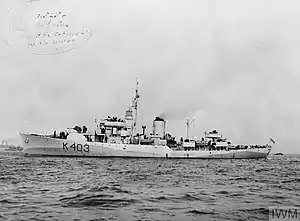 HMS Arbutus | |
| History | |
|---|---|
| Name | HMS Arbutus |
| Namesake | Arbutus |
| Builder | Blyth Shipbuilding & Drydock Co. Ltd |
| Laid down | 30 November 1939 |
| Launched | 5 June 1940 |
| Commissioned | 12 October 1940 |
| Identification | Pennant number: K86 |
| Fate | Torpedoed and sunk by U-136, 5 February 1942 |
| General characteristics [1][2] | |
| Class and type | Flower-class corvette |
| Displacement | 925 long tons (940 t) |
| Length | 205 ft (62 m) |
| Beam | 33 ft (10 m) |
| Draught | 13.5 ft (4.1 m) |
| Installed power | 2,750 ihp (2,050 kW) |
| Propulsion |
|
| Speed | 16.5 knots (30.6 km/h; 19.0 mph) |
| Range | 3,500 nmi (6,500 km; 4,000 mi) at 12 knots (22 km/h; 14 mph) |
| Complement | 85 |
| Armament |
|
HMS Arbutus was a Flower-class corvette of the Royal Navy, which was active during the Second World War. She was a successful escort vessel, and took part in the destruction of two U-boats during the Battle of the Atlantic. Arbutus was sunk in the North Atlantic in February 1942.
Construction
Arbutus was placed on order in July 1939, one of the first 26 "Flowers" of the pre-war building programme. She was laid down at the Blyth Shipbuilding Company, at Blyth, Northumberland, on 30 November 1939. She was launched on 5 June 1940 and completed 12 October 1940.[3] She commissioned on the same day under the command of Lt. Cdr. H Lloyd Williams, RNVR,[4] one of the earliest Volunteer Reserve command appointments.
World War II service
After trials and working up Arbutus joined Western Approaches Command and was assigned to 6 Escort Group, led by JM Rowland in HMS Wolverine for convoy escort duties. In this role she was engaged in all the duties performed by escort ships; protecting convoys, searching for and attacking U-boats, and rescuing survivors. Over the next 14 months Arbutus escorted 26 convoys on the Atlantic routes,[5][6] helping to bring over 750 ships to safety, though a number were lost in various incidents. She was involved in two convoy battles, and helped destroy two U-boats.
In March 1941, Arbutus, with 6 EG, escorted convoy OB 293 when it came under attack by a force of U-boats. The escort group mounted a vigorous and aggressive defence, resulting in the destruction of two U-boats and damage to a third, for the loss of two ships sunk and three damaged. During the two-night action, on 7 March 1941, Arbutus and Camellia found and attacked U-70; she was depth-charged and brought to the surface, where she was abandoned and sank.[7]
In April 1941 6EG went to the aid of convoy SC 26 which was under attack. On 5 April Arbutus, with Wolverine and Scarborough, found and attacked U-76, which was brought to the surface and abandoned. As she surfaced Arbutus was closing in order to ram her; when he saw she was being abandoned Arbutus' then commander, Lt. ALW Warren, changed plans and attempted to capture the submarine before it sank. U-76 was boarded by several members of the corvette's crew, and efforts were made to secure and search the boat while Arbutus made fast to the U-boat with hawsers. However, U-76 was sinking too fast, and the capture failed. This was the first such instance of a U-boat boarding and acquisition in World War II, though it was unsuccessful;[8] the exploit was repeated the following month when U-110 was captured by ships of 3 Escort Group.
Fate
On 5 February 1942 Arbutus was escorting convoy ON 63 when it was detected by U-136. The U-boat sent a sighting report and commenced shadowing, but the transmission was DFed and escorts Chelsea and Arbutus ran down the bearing to attack. The U-boat commander, K/L H Zimmerman, responded aggressively, counter-attacking and torpedoing Arbutus as she approached. The corvette broke in half and sank, with the loss of half her crew.[9] 43 men, including her commander, were lost.[10] U-136 was subsequently depth-charged by Chelsea, damaged and forced to abandon her pursuit, saving ON 63 from further harm.[9]
Successes
During her service Arbutus was credited with sharing in the destruction of two U-boats:
| Date | U-boat | Type | Location | Notes |
|---|---|---|---|---|
| 7 March 1941 | U-70 | VIIC | N Atlantic, N of Rockall 60°15′N 14°00′W / 60.250°N 14.000°W | Rammed by Mijdrecht, D/C by Arbutus, Camellia; forced to surface, abandoned, sunk[11][12] |
| 5 April 1941 | U-76 | VIIB | N Atlantic, S of Iceland 58°35′N 20°20′W / 58.583°N 20.333°W | D/C by Wolverine, Scarborough, boarded by Arbutus; sank due to damage received[13][14] |
Notes
- ↑ Conway p62
- ↑ Elliot p84
- ↑ Elliot, p. 85
- ↑ Arbutus at uboat.net
- ↑ A Hague: convoyweb.org.uk
- ↑ G Mason: navalhistory.net
- ↑ Blair pp. 249–251
- ↑ Blair pp. 265–266
- 1 2 Blair p. 550
- ↑ loss of Arbutus at uboat.net
- ↑ Kemp, p. 68
- ↑ Neistle, p. 43
- ↑ Kemp, p. 69
- ↑ Neistle, p. 40
References
- Blair, Clay (1996). Hitler's U-Boat War: The Hunters 1939-1942. Cassell. ISBN 0-304-35260-8.
- Gardiner, Robert; Chesneau, Roger, eds. (1980). Conway's All The World's Fighting Ships 1922–1946. London: Conway Maritime Press. ISBN 0-85177-146-7.
- Elliott, Peter (1977). Allied Escort Ships of World War II: A complete survey. London: Macdonald and Jane's. ISBN 0-356-08401-9.
- Arnold Hague: The Allied Convoy System 1939–1945 (2000). ISBN (Canada) 1 55125 033 0 . ISBN (UK) 1 86176 147 3
- Kemp, Paul (1997). U-Boats Destroyed, German submarine losses in the World Wars. Arms and Armour. ISBN 1-85409-515-3.
- Niestle, Axel (1998). German U-Boat Losses During World War II. Greenhill. ISBN 1-85367-352-8.